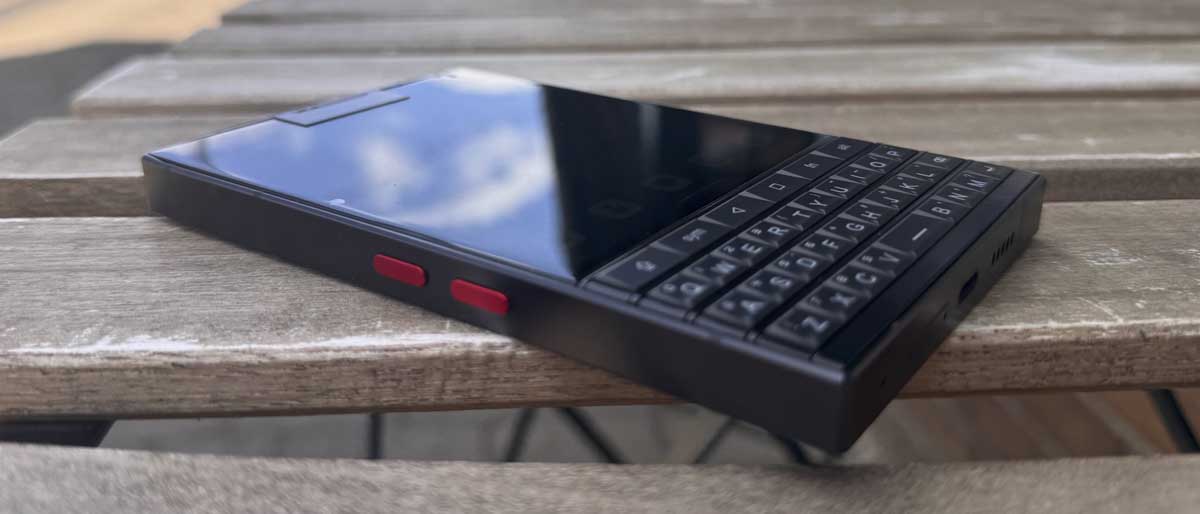TechRadar Verdict
I didn't expect to like this phone as much as I did. Though a little large, it's slim and pocketable, with a Blackberry-style Qwerty keyboard, responsive touchscreen, dual SIM, and modern OS all coming together to offer retro-style functionality, although, in some cases, it is a little underpowered when it comes to processing.
Pros
- +
Large square screen
- +
Physical keyboard
- +
Dual SIM card slots
Cons
- -
Just a little too large
- -
A combination of physical and touch won't suit everyone
Why you can trust TechRadar
Unihertz Titan 2: 30-second review
Unihertz already has a good line of this style of phone on the market, reaching a dedicated audience of users, but the Titan 2 aims to be something a little different with its vintage styling, updated Qwerty keyboard and square screen, giving a distinctive look and feel.
One of the aspects I instantly liked was that, whilst it's quite large, especially that square screen, it's relatively slim, just a little thicker than your average iPhone.
From the outset, the thing that stood out was the square ratio of that screen, measuring 80 x 80 mm, with a diagonal of 4.5 inches. That might not sound big compared to more usual portrait-ratio devices, but in use, the screen feels much larger and far more usable, particularly when typing, although there are some apps where it's not best suited.
Typing is another key aspect that sets this phone apart. The Qwerty physical keyboard isn't just there in isolation but works in combination with the touchscreen functions. You can use the top row of buttons to activate Shift, symbols, Alt and more, quickly switching layouts and accessing additional options.
When navigating documents, especially Google Sheets and Docs, it became hard to go back to my iPhone; it just seemed limited in space, and the Titan 2 just felt more intuitive.
There are some downsides, and size is the most obvious. It does fit into a trouser pocket, but at around 90 mm wide, compared to the iPhone's roughly 70 mm, the difference is noticeable.
Interestingly, Unihertz seems to lean into this size, with marketing material showing the phone paired with a leather belt holster, giving it a distinctly retro twist. That holster not only makes it more comfortable to carry but helps protect the screen.
Sign up to the TechRadar Pro newsletter to get all the top news, opinion, features and guidance your business needs to succeed!
In use, the Android 15 OS works seamlessly, supporting all the usual apps for work and entertainment. A standout feature is the dual SIM capability, letting you switch between work and personal profiles in the settings.
The rear camera doesn't feature a high-end sensor, but the image quality is perfectly decent for capturing moments, work content or general scenery.
While the main appeal is clearly the unique design, in practice, the Titan 2 proves itself genuinely functional. It's closer to a portable computer than a phone in many ways, particularly for Google Docs and work tasks, although for some apps, the square ratio was a bit of an issue.
Alright, it might not be the best phone around - but the Titan 2 is Vintage in appearance but surprisingly usable; it offers solid functionality at a very reasonable price.
Unihertz Titan 2: Price and availability
- How much does it cost? from $269
- Where can you get it? Kickstarter
At present, the Unihertz Titan 2 is on a Kickstarter campaign with a price of $269, with a recommended retail price that is more likely to be around the $399 mark.
If you are looking for a phone with a slightly larger screen and definite vintage appeal, then this is absolutely superb value for money whilst it's at this offer price.
You can check out the Kickstarter page by clicking here.
- Value: 4 / 5
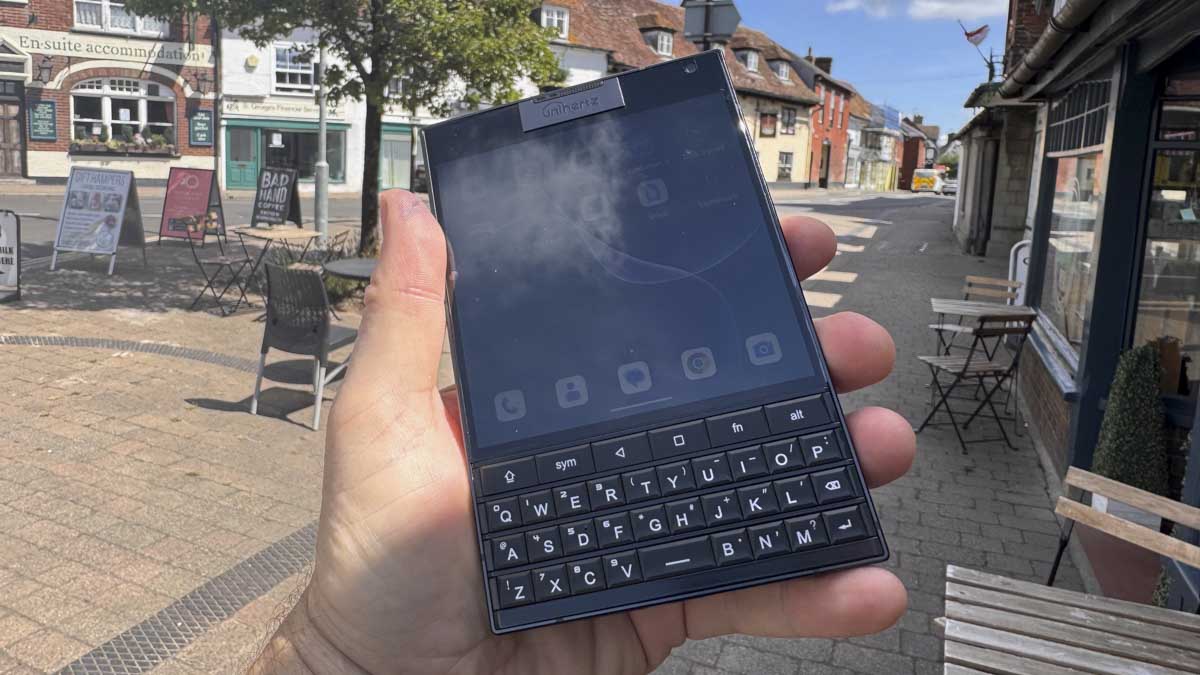
Unihertz Titan 2: Specs
CPU: MediaTek Dimensity 7300
Graphics: /
RAM: 12GB RAM LPDDR5
Storage: 512 GB ROM UFS 3.1
Ports: 3.5mm audio, USB-C
Connectivity: Wifi, BlueTooth 5.4, NFC, 5G, GPS + GLONASS + BEIDOU + Galileo
Audio: /
Camera: 50MP Main, 32MP Front 8MP 3.4x Telephoto
Size: 137.8 x 88.7 x 10.8mm
OS installed: Android 15
Accessories: Screen protector, power adapter, USB-C to USB-C cable
Unihertz Titan 2 : Design
Unihertz has already launched 10 successful Kickstarter projects, and the Titan 2 is the latest in their range of unique smartphones. It isn't the first they've released with a physical Qwerty keyboard, and once again, the combination of that keyboard and square screen makes it stand out. In use, that difference quickly becomes apparent.
The design feels like something from the late '80s or early '90s, with a large screen and keyboard maximising screen real estate while mimicking a traditional desktop layout. Backed by Android 15 and Unihertz's integrated keyboard system, the touchscreen and keyboard work together to deliver an intuitive workflow.
Physically, it measures 137 x 88.7 x 10.8 mm, and that translates in the hand as feeling quite a bit bigger than most phones, but it's still slim enough to handle comfortably. The QWERTY keyboard has excellent button actuation and, combined with touchscreen input, allows fast access to symbols, features, and word recognition tools for quicker typing.
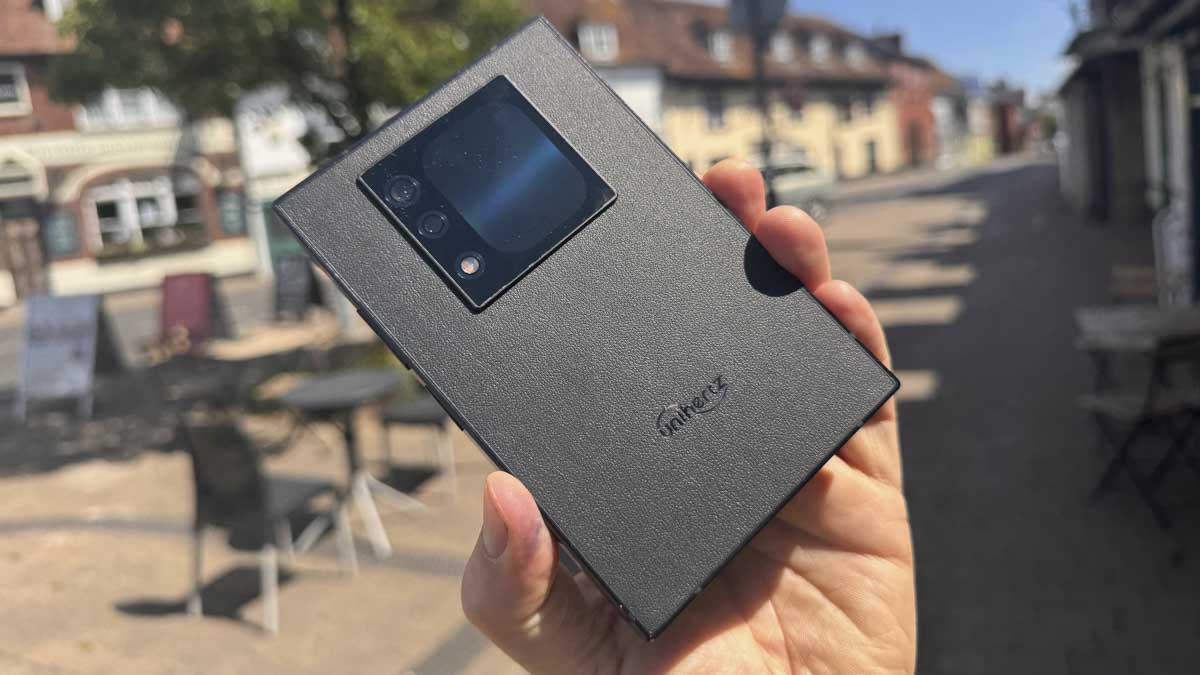
At 235 g, it's slightly heavier than average but well-balanced for its size and function. The 4.5-inch main display has a 1:1 ratio and 1440 x 1440 resolution, feeling much larger in use than typical smartphone screens.
A secondary rear screen displays notifications and a clock, which is handy during meetings. Camera-wise, there's a 50 MP main, an 8 MP 3.4x zoom, and a 32 MP front-facing lens, suitable for most image capture.
The dual SIM setup allows easy switching between work and personal lines, a major plus. Design-wise, it's all very retro. On the right of the phone, there's the power/fingerprint and volume; on the left, two red programmable buttons; underneath: USB-C and SIM tray.
Included is a TPU case and a leather pouch is also promoted in the Kickstarter campaign, fitting the retro theme, and I would suggest it is probably a good idea.
- Design: 4.5 / 5
Unihertz Titan 2: Features
Taking a look at a few key features, the large 4.5-inch screen with its 1440 x 1440 resolution immediately stands out. It's very different from the usual portrait-style phone, making it a great option for working with Google Docs and other work applications.
Another feature that's a little different but I have seen on other Unihertz phones is the second display on the back. This smaller display is designed to show a clock or notifications and is a handy addition.
Battery life is also relatively good, and Unihertz has included a 5,050 mAh battery with 33 W fast charging, allowing a full charge from zero in under 90 minutes; depending on use, it should also last you a full day of standard use.
Balancing work and creativity, the dual-lens rear camera setup includes a 50 MP main camera and an 8 MP telephoto lens, while the 32 MP front camera is suitable for video calls and selfies. While not high-end or branded, the camera performance is decent for the price.
As I have seen with many Unihertz rugged models, this phone features two customisable side buttons that let you assign quick access to frequently used apps or functions.
Dual SIM support is provided for nano SIMs. You can run personal and work numbers on the same device, switching between them in the settings, or keep one on standby as a backup network. Connectivity options include Bluetooth 5.4, NFC, infrared, dual-band GPS and Wi-Fi.
The phone comes pre-installed with the latest version of Android 15, so you have full access to all the core Google apps and tools, including Gemini AI, Wi-Fi display and Chromecast, features that work smoothly thanks to reliable Wi-Fi performance.
The internal hardware is powered by a Dimensity 7300 5G octa-core 2.0–2.6 GHz CPU, which is more than capable of handling standard Google-based applications and documents, though it's not intended for intensive creative or gaming use, although it did run NFS No Limits without issue.
Overall, the feature set clearly targets productivity, pairing well with the retro design, keyboard, and square screen.
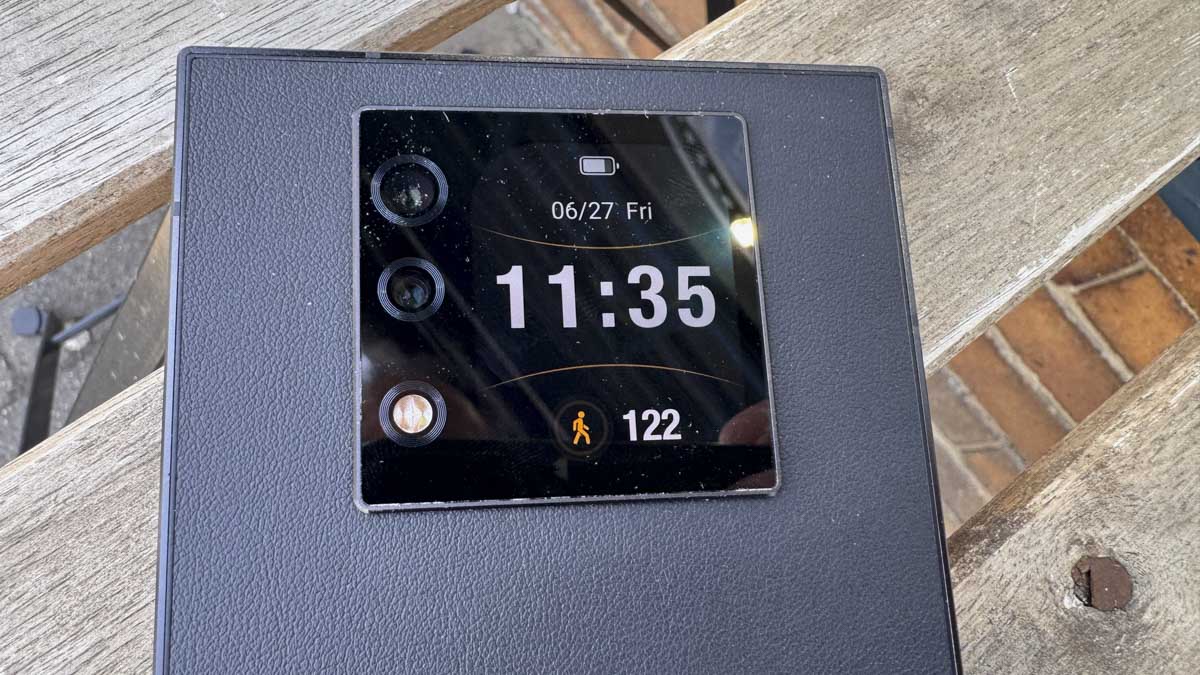
- Features: 5 / 5
Unihertz Titan 2: Performance
Disk Speed Test Read: 450 MB/s
Disk Speed Test Write: 1812 MB/s
Geekbench CPU Multi: 3271
Geekbench CPU Single: 1035
Geekbench GPU: 2489
Wild Life Overall: 3309
Slingshot: 7298
Steel Nomad Overall: 361
Getting started with the phone is straightforward, thanks to the ease of Android 15. You can transfer data from your existing phone, so you don't need to reinstall every app or reload documents manually unless you're starting with it as a new phone.
Once the phone is set up, it's quick and easy to get into the workflow. The combination of physical and touchscreen keyboards is surprisingly intuitive. Once you get the hang of using the Shift, symbol, and function keys, navigating settings, typing emails, and handling documents becomes much quicker and more accurate, especially when editing text.
Opening Google Docs gives you far more screen real estate than expected, and reading through documents felt far more comfortable than on a typical smartphone.
I also tried Microsoft Word, and it was just as smooth. With the 4.5-inch square display and physical keyboard, I found myself making far fewer typing mistakes than I do on touch-only screens, which I've always struggled with slightly.
A surprise was the 50 MP camera. Although it doesn't use any branded sensor, it produces good enough images for general use. I was able to import photos directly into Adobe Lightroom for light editing. The large screen really helps here, and although not the highest resolution, it's very usable, offering enough clarity for mobile edits.
At first, I thought the physical keyboard and square screen might be a gimmick. But the more I used them, the more they made sense. While the size is too large to comfortably pocket all the time, Unihertz's option of a leather holster makes a lot of sense and also adds to the look if that's what you're after. It suits the retro theme and adds practicality and protection.
Despite the retro styling, usability is good; this isn't a case of form over function. Watching media, browsing the web, editing documents, and typing feel more satisfying on this larger format than on most phones, although not all apps are optimised for their use.
After a week of using it as my main device, I can say I genuinely prefer the physical keyboard and touchscreen combo over the virtual keyboard on my iPhone. It's more accurate and easier to navigate, and the square screen is a real plus, visually and functionally.
The phone handles the Google ecosystem well. Biometric fingerprint and facial recognition work smoothly. Performance was good for standard productivity tasks, although things did slow slightly with large documents.
Pushing the phone with Adobe Lightroom, I found simple photo edits manageable, but heavier tasks revealed their limits. It's not a powerful device, and that became more apparent with gaming. Benchmarks like Steel Nomad returned a score of 361, which translates to a low average frame rate, unsuitable for advanced gaming. However, loading up NFS No Limits and this game proved to be perfectly playable.
So, while the Titan 2 is excellent for Google Applications, document handling, and daily use, it's not built for creation or graphics-heavy applications. That said, for light video edits in CapCut, a few tweaks of tones in Lightroom and a few more hours wasted playing NFS No limits it's actually perfectly good.
- Performance: 4 / 5
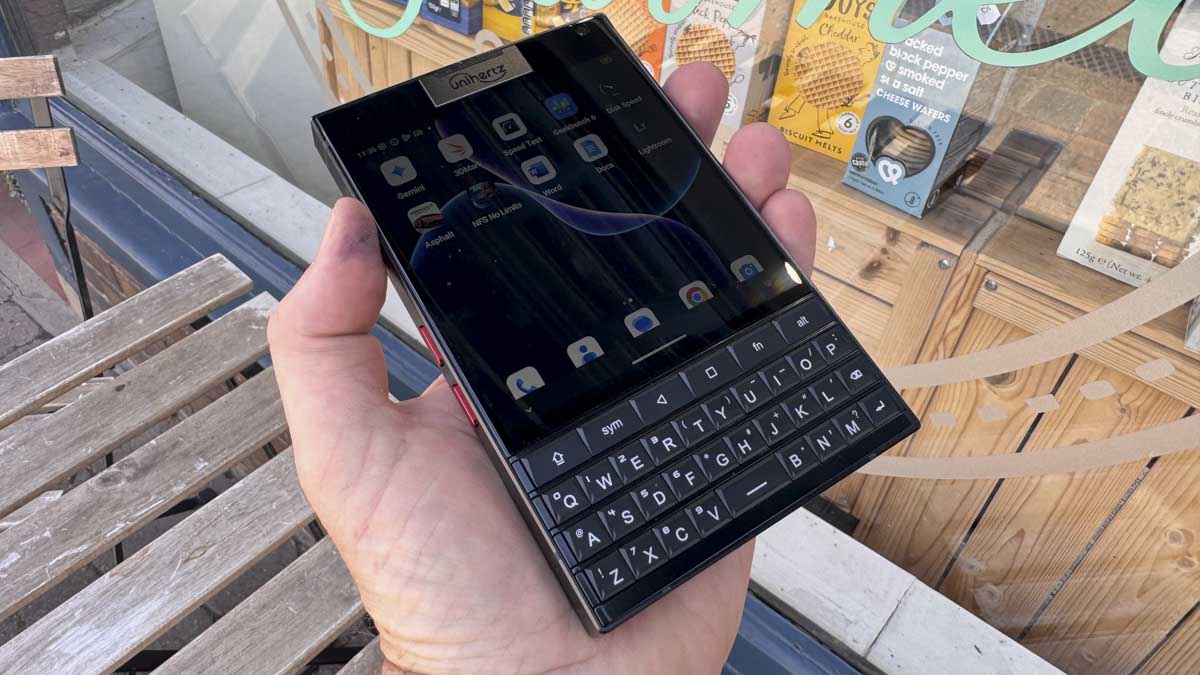
Unihertz Titan 2: Final verdict

It's always interesting testing a phone where the vintage look and style are central to its identity. But once you start using it in real-world situations, the combination of physical keyboard and touchscreen really begins to make sense. It's an intuitive and practical way of working, particularly with Google Docs and other work-focused apps.
When pushed for content creation in apps like Lightroom or used for gaming, the limitations of the processing power become clear. Light photo and video edits are possible, but things slow down quickly with more demanding tasks. Gaming, especially graphics-heavy titles, highlights these limits even further, although I did spend rather too long playing NFS No Limits.
Where this phone excels is workflow. The dual SIM slots allow for switching between work and personal numbers through the settings, and the physical keyboard and square screen all work incredibly well offering a good alternative to the now mainstream touch screen devices.
What stands out is how well it caters to those who appreciate retro-styled tech. If you used devices like the Psion or BlackBerry during the early days of mobile computing, this feels like a natural progression. It won't set performance records, but in terms of practical day-to-day usability—particularly for typing and document handling—it delivers a refreshingly different experience from the typical smartphone.
Should I buy a Unihertz Titan 2?
Value | Exceptional value for money if you're looking for a work-based phone | 5 |
Design | The design makes sense, but it's a little bit too large to be easily pocketable | 4 |
Features | Solid features that balance overall performance with price | 4 |
Performance | Physical use is exceptionally good, with easy document editing. However, it is slightly underpowered | 4 |
Overalls | Generally a good balance of features, performance and price with a strong vintage feel | 4 |
Buy it if...
You like vintage electronics.
<p>Everything about this smartphone harks back to the early era of mobile computing, with a physical keyboard, a large square screen, and even a vinyl finish on the back.<p><strong>You need a work phone.<p> It might not be pocketable, but with a physical keyboard and touchscreen combo, it makes typing on work documents exceptionally easy.Don't buy it if...
You need a pocket mobile phone.
<p>Whilst it will fit in your pocket, the width of the phone is just a little too large to be comfortable, so you will need to keep it in your bag—or, more preferably, buy the add-on leather holster.<p><strong>You need power<p>While the phone will handle Google Docs and other workflow applications relatively well, when it comes to anything that needs graphics performance, look elsewhere.You must confirm your public display name before commenting
Please logout and then login again, you will then be prompted to enter your display name.
